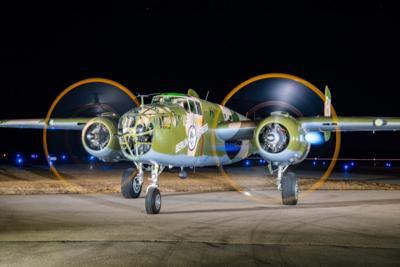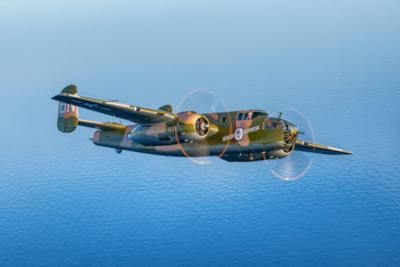All Aboard the Berlin Express
Comprising some 270,000 members organized into nine-hundred local chapters, the Oshkosh, Wisconsin-based Experimental Aircraft Association (EAA) embodies the spirit of aviation by actively promoting the enjoyment and camaraderie of building, restoring, and flying recreational aircraft.

On 05 April 2023, the EAA announced that its B-25 Mitchell, dubbed Berlin Express, will presently embark on a tour of eight U.S. states, during which history buffs and aviation enthusiasts will be afforded opportunities to fly aboard the storied World War II era aircraft.
The tour’s first scheduled stop will be in Wisconsin’s capital city, Madison, where the B-25 will remain from 02 to 04 June. Additional stops include a 16 to 18 June stint in Terre Haute, Indiana; and a 14 to 16 July stopover in Ankeny, Iowa. The slick, twin-engine, medium bomber will subsequently return to Oshkosh, where it will remain throughout EAA AirVenture 2023, providing rides to event attendees intrigued by the notion of viewing the world’s largest fly-in from the crew-compartment of one of WWII’s most legendary fighting aircraft.
More stops will be added to the B-25’s summer schedule as details are finalized.
Tickets aboard the Berlin Express are $425 for adult EAA members and $475 for adult nonmembers. Once the aircraft is airborne, passengers will be allowed to move freely about its interior for purpose of changing vantage points and exploring the bomber’s various compartments. Each flight experience spans approximately one hour, including briefing, debriefing, and about 18 minutes of flight time.
ntroduced in 1941 and named in honor of U.S. military aviation pioneer Major General William “Billy” Mitchell, the B-25 is a twin-reciprocating-engined, mid-wing, H-tail medium bomber with a retractable tricycle undercarriage. The aircraft’s 52’, 11” fuselage bisected a 67’, 7” main-wing and was capable of carrying three-thousand-pounds of conventional bombs.
The B-25’s pair of 1,700-horsepower Wright R-2600-92 Twin Cyclone, 14-cylinder, two-row, air-cooled radial engines handily bore the bomber’s 35,000-pound Maximum Gross Takeoff Weight (MGTOW) to a service-ceiling of just over FL240 and a Vne of 236-knots. Cruise speed was a comparatively leisurely 200-knots, which likely felt very slow indeed to the aircraft’s five-man crew as it lumbered through the flack-dense skies of WWII’s European and Pacific theaters alike.
Produced in numerous variants, some 9,816 B-25s were built between 1939 and 1945. The type remained in service across the world for over four decades.

The B-25 was a safe and forgiving aircraft to fly. Operating on a single engine, the machine could be banked 60° into its inoperative engine, and remain wholly controllable to a speed of approximately 126-knots. In the event of an engine failure on takeoff, however, B-25 pilots were obligated to maintain directional control of the climbing bomber solely by rudder inputs, as attempting to utilize the airplane's ailerons prior to reaching approximately 120-knots too often resulted in catastrophic snap-inversion.
On the ground, the B-25’s tricycle landing gear made for excellent visibility while taxiing.
All and all, the only gripe pilots and air-crews made consistently about the B-25 was in regard to excessive engine noise, which was due to the mills’ exhaust stacks protruding directly from the cowling ring. The atypical design—ascribed to space restrictions peculiar to the B-25’s mid-wing and ovular fuselage—directed exhaust and noise directly at and into the pilot and crew compartments. The B-25’s interior was, in fact, so riotously loud that many air-crew members assigned to the type developed hearing loss.
 Senator Pushes FAA to Accelerate Rocket Launch Licensing
Senator Pushes FAA to Accelerate Rocket Launch Licensing Classic Aero-TV: RJ Gritter - Part of Aviations Bright New Future
Classic Aero-TV: RJ Gritter - Part of Aviations Bright New Future Aero-FAQ: Dave Juwel's Aviation Marketing Stories -- ITBOA BNITBOB
Aero-FAQ: Dave Juwel's Aviation Marketing Stories -- ITBOA BNITBOB ANN's Daily Aero-Linx (10.27.24)
ANN's Daily Aero-Linx (10.27.24) ANN's Daily Aero-Term (10.27.24): Clearance Void If Not Off By (Time)
ANN's Daily Aero-Term (10.27.24): Clearance Void If Not Off By (Time)




